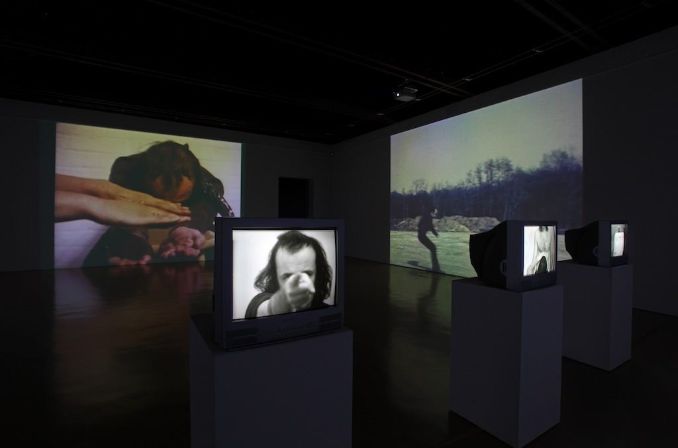Brilliant City is a compelling group exhibition that explores the ongoing processes of urbanisation and globalisation, particularly in the context of the changing urban environments in China and the UK. The exhibition was a collaboration between Chinese and British artists, created during the preparations for the 2008 Beijing Olympics—a period of significant infrastructural transformation in China. Through sound and video art, the exhibition delves into the effects of rapid urbanization, emphasizing how monumental construction projects are reshaping not only cityscapes but also the social fabric of both rural and urban populations.
Zhong Minjie, a Guangzhou-based sound artist, was invited to contribute to this exploration. His work reflects the tensions between past and present as cities evolve. Zhong’s piece focuses on the commodification of space in China’s fast-growing urban centers, highlighting how the influx of rural residents seeking better lives in cities has led to the growth of an urban underclass. His sound art conveys the desolation of vacant cityscapes: highways devoid of traffic, streets empty of people, and buildings looming large in the absence of human scale. These sonic landscapes underscore the alienating effects of modernity, where the physical structures dominate and render human presence almost invisible.
The exhibition brought together a range of diverse artists to foster discussions on the complexities of urban life in the modern world, creating a rich and multifaceted exhibition that resonated with audiences globally. Finding inspiration from the ideas of Walter Benjamin, particularly his concept of the “dream city”, drawing attention to how advertising and the commodification of urban spaces have shaped public perceptions of cities as utopias. Yet, in the artworks presented, this idealized vision is critically examined. Artists, including Zhong, use sound and video to explore the gaps between the official narratives of progress and the realities of displacement and loss. Their work critiques how the promise of a better future often comes at the expense of marginalized communities who are left behind in the wake of urban transformation.
What sets Brilliant City apart is its collaborative nature, which brought together artists from China and the UK, fostering an exchange of ideas and methodologies. Zhong Minjie’s participation in the UK research phase allowed him to deepen his understanding of urbanization’s impact in both countries, contributing to a dialogue that transcended borders. The exhibition not only highlighted the rapid urban growth in China but also served as a platform for global reflection on how cities across the world are being reshaped by economic forces.
The exhibition travelled to multiple locations around the world, including London, Auckland, Tokyo, and Chongqing, broadening the conversation around urbanization and offering a global perspective on the challenges and opportunities posed by rapid city development. The international nature of the project allowed artists to engage with audiences from different cultural backgrounds, furthering the discourse on urbanization’s social, political, and environmental effects.
In its entirety, Brilliant City acts as a critical examination of the commodification of urban spaces and the profound consequences of globalization. Zhong Minjie’s sound art serves as a powerful tool for illustrating the absence of people in modern cities, emphasizing the alienation that often accompanies the push for progress. It calls attention to the disconnect between the promises of modernization and the reality of urban landscapes shaped by inequality and displacement.
The Brilliant City project, which was a collaboration between Chinese and British artists, explored the rapidly evolving urban landscapes of both countries through the mediums of sound and video. The work of emerging artists, including 8gg, Actop, B6, Michael Faulkner, Matthias Kispert, and Zhong Minjie, reflected on themes related to urban architecture, social change, and the ongoing economic transformation driven by globalization. Each artist approached these themes through their unique lens, offering critical insights into the growing urbanization and its impact on both the built environment and the people inhabiting it.
The collaboration was particularly significant in its international exchange, as artists from different cultural backgrounds engaged with the themes of urbanization and globalization in a variety of ways. Zhong Minjie, for instance, was invited to the UK to assist in the research and development of the project, with a focus on Liverpool and London. His contributions were part of a broader exploration of how cities around the world—particularly in China—are grappling with the tensions between progress and displacement in the face of rapid urban growth.
Watch >> Work
The artistic network formed during this research phase helped build a framework for collaboration between international artists, providing opportunities for dialogue and shared experiences. This led to further developments, such as 8GGpresenting their work at CineCity Brighton 2006, and a series of residency programs that deepened the engagement with urban issues. The artists’ research, conversations, and collaborative processes culminated in an exhibition that toured several international art festivals.
Brilliant City exhibition toured multiple locations, including the Kinetica Art Fair in London, the MIC Toi Rerehiko in Auckland, New Dis-Locate Festival in Tokyo and Yokohama, the CineCity Festival in Brighton, MU Eindhoven, the UK Arts Festival in Chongqing, and more. This global tour not only showcased the work of emerging artists but also brought attention to the socio-economic shifts and urban transformation shaping cities across the world. It was a powerful reminder of how art can bridge the divide between theoretical discourse and real-world experiences, offering insightful reflections on the urban environments we inhabit.
The exhibition was co-curated and produced by Keith Whittle, Keri Elmsly, Michael Faulkner, and Matthias Kispert, with substantial support from Arts Council England, the British Council China, and Visiting Arts.









